Patsy T. Mink Papers at the Library of Congress
Originally published in slightly abridged form in "Collection Focus: Patsy T. Mink Papers, Manuscript Division," by Janice E. Ruth, Library Services Journal vol. 1, no. 1 (Spring 2008): 13-16 (Washington: Office of the Associate Librarian for Library Services, Library of Congress).
In 2007, the Manuscript Division celebrated the completion of a 3½-year project to process the rich and voluminous papers of former Hawaii representative and Title IX advocate Patsy T. Mink (1927-2002), which had been donated to the Library in 2003 by Mink’s husband and daughter. A copy of the extensive finding aid is available on the division’s Web site.
Congresswoman Mink was a vigorous and tireless champion of women's rights, an early and vocal opponent to the Vietnam War, and a leader on issues involving education, the environment, welfare, and civil rights. With her election in 1964, Mink became the first woman of color and the first Asian American woman to serve in Congress. She represented the people of Hawaii during two periods, the first from 1965 to 1977 and again from 1990 until her death in 2002. In between, she served in the Jimmy Carter administration as an assistant secretary of state for oceans and international, environmental, and scientific affairs (1977-78), was president of Americans for Democratic Action (1978-81), served on the Honolulu City Council (1983-87), maintained a private law practice (1987-90), and founded the Public Reporter (1989-91), an organization that monitored and publicized the activities of the Hawaii state legislature.
The Mink collection, which numbers nearly 900,000 items, is arranged in 2,710 boxes and is described in a 700-plus-page finding aid. Senior archives specialist Margaret McAleer directed a team of two archivists, twelve archives technicians, and nine interns during the course of the project. A sampling of items from the collection appears below, most of which relate to Mink’s political service. All phases of her life, however, are represented in the larger collection, which includes personal and professional correspondence, daily schedules, central legislative files, bills, issue mail, speeches, clippings, press releases, scrapbooks, photographs, and other personal papers covering a wide array of topics and concerns. |
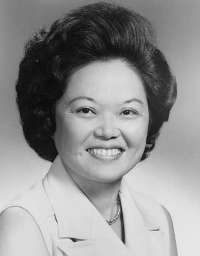
Patsy Mink, ca. 1965. Photographer unknown. Congressional Portrait File, Prints and Photographs Division, Library of Congress, LC-USZ62-122137.
|
Official portrait of Hawaii territorial senate, 1958.

Official portrait of Hawaii territorial senate, 1958. Patsy T. Mink Papers, Manuscript Division.
|
Reflective of a lifetime of “firsts” and barrier-breaking accomplishments, a thirty-one-year-old Patsy T. Mink, who had become both the first Japanese-American woman admitted to the Hawaii bar (1953) and to serve in the Hawaii territorial house of representatives (1956), is shown in this 1958 official portrait of the Hawaii territorial senate, surrounded by a sea of men, including future U.S. Senator Daniel K. Inouye (second row, second from left) and Hawaii governors George Ariyoshi (second row, seventh from left) and Oren E. Long (first row, fourth from right). Mink, along with Inouye and Ariyoshi, was part of a group of reform-minded young Democrats who were rising to prominence at a pivotal time as the territory of Hawaii approached statehood in 1959. |
Patsy T. Mink, undated handwritten notes for speech given in support of civil rights plank at the Democratic National Convention, Los Angeles, California, July 12, 1960.
Mink’s work with the Young Democratic Clubs of America led to her role as an Adlai Stevenson delegate and platform committee member at the 1960 Democratic National Convention in Los Angeles. Like many politicians before her, Mink grabbed whatever scrap of paper was in easy reach (an empty envelope) and began drafting a speech to second the Democratic Party’s civil rights plank, which she would later deliver before 10,000 delegates and a national television audience on July 12, 1960. Although many news accounts the next day invariably commented on Mink’s size and appearance – “the lovely Oriental doll of a delegate” and “diminutive and attractive” being but two examples– it was her impassioned support of civil rights that “drew repeated, prolonged, and swelling cheers.” A complete handwritten draft of Mink’s 1960 speech is in the collection as are countless other documents reflecting her lifelong commitment to civil rights.
|

Patsy T. Mink, undated handwritten notes for speech given in support of civil rights plank at the Democratic National Convention, Los Angeles, California, July 12, 1960. Patsy T. Mink Papers, Container 5, Manuscript Division. Used with permission of Gwendolyn Mink.
Back of envelope |
Transcript
|
Patsy T. Mink to Martin Luther King, Jr., January 7, 1965.
Immediately upon being sworn into Congress on January 4, 1965, Mink was at the forefront of the effort to challenge the seating of the all-white Mississippi congressional delegation and postpone their swearing in until the House Administration Committee could investigate the state’s 1964 elections, which were being contested as unconstitutional because of widespread voter discrimination, intimidation, and violence against African American voters. In this retained copy of her letter of January 7, 1965, Mink explains to Martin Luther King, Jr., what transpired on the House floor concerning this ultimately unsuccessful effort, which he and other civil rights leaders had helped to organize. |
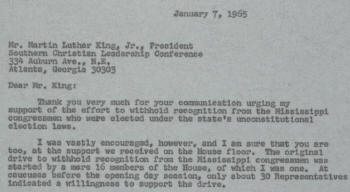
Patsy T. Mink to Martin Luther King, Jr., January 7, 1965. Patsy T. Mink Papers, Container 74, Manuscript Division. Used with permission of Gwendolyn Mink.
|
Patsy T. Mink campaigning with family and supporters, [1966].
Throughout her career, Mink maintained an independence from state party leaders and relied heavily on her supportive family and volunteers to mount grassroots campaigns financed mainly through small individual contributions. This was certainly the case in 1966 when (left to right) Mink, her daughter Gwendolyn, and husband John, whom Patsy later called her “principal sounding board” in a 1979 oral history interview with Fern Ingersoll, present reelection posters and bumper stickers to a supportive local gas station owner. (The Ingersoll interview is preserved in the Manuscript Division’s Former Members of Congress, Inc., Oral History Collection, Box 8.) |
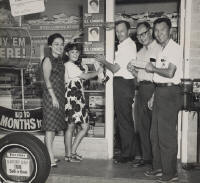
Patsy T. Mink campaigning with family and supporters, [1966]. Photographer unknown. Patsy T. Mink Papers, Container 826, Manuscript Division. Used with permission of Gwendolyn Mink.
|
Patsy T. Mink, typewritten statement opposing G. Harrold Carswell’s Supreme Court nomination, January 27, 1970.
Issues and concerns which engaged Mink during her first stint in Congress often resurfaced in later years. On January 27, 1970, Mink testified before the Senate Judiciary Committee to oppose the Supreme Court confirmation of Judge G. Harrold Carswell. Like others, Mink objected to Carswell’s public statements in 1948 in support of white supremacy and racial segregation, but she also drew attention to his record on women’s rights and his vote to deny a rehearing of a sex discrimination case involving a woman denied employment because she had pre-school-age children. Twenty-one years later, Mink was one of the seven women members of Congress who marched from the House to the Senate side of the Capitol to demand that the Senate delay its scheduled vote on the confirmation of Supreme Court nominee Clarence Thomas and investigate more fully allegations that he sexually harassed former assistant Anita Hill.
|
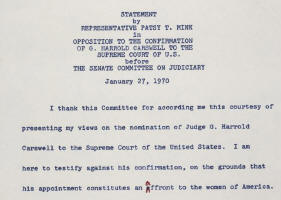
Patsy T. Mink, typewritten statement opposing G. Harrold Carswell’s Supreme Court nomination, January 27, 1970. Patsy T. Mink Papers, Container 389, Manuscript Division. Used with permission of Gwendolyn Mink.
|
John W. Dean to Patsy T. Mink, July 30, 1971, concerning freedom of information.
In 1971 the Atomic Energy Commission sought to detonate a large underground nuclear test, code-named Cannikan, at Amchitka Island in the Aleutian chain off Alaska. A longtime critic of nuclear testing in the Pacific, Mink was concerned that the Cannikan test would touch off a tsunami and endanger lives. She sought to block the test through the appropriations process and requested the release of documents believed to show that five agencies recommended canceling the test. Her request was denied per this letter from White House Counsel John W. Dean III. This refusal led Mink and thirty-two other members of Congress to sue the Environmental Protection Agency under the 1966 Freedom of Information Act (FOIA). Although the plaintiffs were unsuccessful in stopping the Amchitka tests or in obtaining access to the Cannikan Papers, Mink v. EPA and EPA v. Mink led Congress to strengthen FOIA and established an important precedent of in camera review of disputed documents that would become central in the legal battle over the release of President Richard M. Nixon’s White House tapes.
|
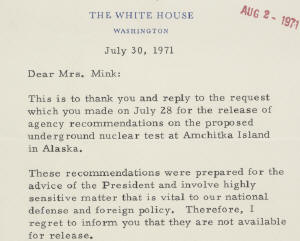
John W. Dean to Patsy T. Mink, July 30, 1971, concerning freedom of information. Patsy T. Mink Papers, Container 50, Manuscript Division.
|
Patsy T. Mink to Carolyn Sullivan, December 3, 1971, regarding child care program.
Having personally experienced the difficulty of raising a child while pursuing a career outside the home, Mink introduced in Congress in May 1967 the first national comprehensive child care bill to provide not just custodial care but educational development to pre-school-age children of all economic backgrounds. She reintroduced the bill in succeeding Congresses gaining additional cosponsors each time until joining her education and labor subcommittee chair John Brademas in introducing a successor bill incorporating many provisions of her earlier legislation. The Brademas bill became an amendment to an Office of Economic Opportunity bill, which passed the House in September 1971. The Senate passed similar legislation, and although many Republican leaders supported it, pockets of opposition remained strong. President Nixon vetoed the OEO bill on December 10, despite attempts by Mink and others to encourage supporters, such as the recipient of this telegram, to lobby for its passage.
|
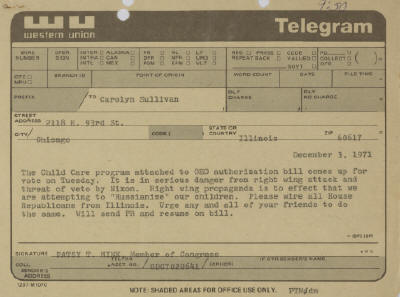
Patsy T. Mink to Carolyn Sullivan, December 3, 1971, regarding child care program. Patsy T. Mink Papers, Container 69, Manuscript Division. Used with permission of Gwendolyn Mink. |
Patsy T. Mink and members of the House Subcommittee on National Parks and Recreation on the Big Island, Hawaii, January 1972.
Although sometimes criticized locally for being too interested in national issues, Mink throughout her career dedicated considerable time and staff resources to constituent concerns, including the rights of Native Hawaiians and the preservation of endangered lands, species, and cultural resources in her state. In January 1972 she and other members of the House Subcommittee on National Parks and Recreation visited the Big Island to hold hearings on two bills Mink was sponsoring to safeguard sacred Native Hawaiian sites. One would establish the Pu’ukohola Heiau National Historic Site and the other would study the feasibility of establishing a national park at the Honokohau National Historic Landmark near Kaloko Pond, the likely site of this photograph. Mink was successful in stopping the Corps of Engineers from issuing a demolition permit for the seawall at Kaloko Pond, and eventually this ancient Hawaiian settlement–an important wetland area for native birds and the presumed burial place of King Kamehameha the Great–was preserved as the Kaloko-Honokohau National Park in 1978.
|

Patsy T. Mink and members of the House Subcommittee on National Parks and Recreation on the Big Island, Hawaii, January 1972. Photographer unknown. Patsy T. Mink Papers, Container 338, Manuscript Division.
|
Patsy T. Mink (left), Mme. Nguyen Thi Binh (center), and Bella Abzug (right) meeting outside Paris, France, regarding Vietnam peace negotiations, [April 21, 1972].
Concerned that the Vietnam War peace talks had become stalled in Spring 1972 and frustrated at the lack of information being provided to Congress by the Nixon administration, Mink (left) and Congresswoman Bella Abzug (right) traveled to Paris in April, where they met with U.S. delegates, North Vietnamese officials, and Mme. Nguyen Thi Binh (center), foreign minister of the Provisional Revolutionary Government of South Vietnam. The three women discussed the need to resume the peace talks, treatment of American prisoners of war, and issues surrounding Vietnamese-American orphans. To Mink’s disappointment, little was accomplished and few new facts emerged. Although other members of Congress made similar trips, Mink’s longstanding opposition to the Vietnam War earned her the epithet “Patsy Pink” and led many military constituents to question her actions. As she recalled in the Fern Ingersoll interview (page 98) previously cited, “It was a case of living up to my own views and my own conscience. If I was defeated for it, that’s the way it had to be.”
|
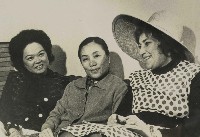
Congresswoman Patsy T. Mink (left), Mme. Nguyen Thi Binh, Foreign Minister of the Provisional Revolutionary Government of South Vietnam (center), and Congresswoman Bella Abzug (right) meeting outside of Paris, France, [April 21, 1972]. Patsy T. Mink Papers, Container 510, Manuscript Division.
|
Patsy T. Mink reviews signatures needed to put her name on the Oregon presidential ballot, March 10, 1972.
At the request of Oregon liberals, Mink agreed in September 1971 to have her name appear on the Oregon presidential ballot to provide a platform to discuss opposition to the Vietnam War, force previous Democratic front-runner George McGovern to resume his antiwar focus, and hold the state’s liberal votes together until its delegates reached the convention that summer. Mink also felt a need to challenge sexist views that only men should run for the presidency. Mink received more than five thousand votes in the Oregon primary on May 23 and smaller numbers in Maryland (573) and Wisconsin (913), where selecting officials placed her name on the ballot. She made no effort to have her name placed into nomination at the Democratic National Convention.
|

Patsy T. Mink reviews signatures needed to put her name on the Oregon presidential ballot, March 10, 1972. [J. E. Ericksen, photographer, Oregon Statesmen.] Patsy T. Mink Papers, Manuscript Division.
|
Patsy T. Mink, typed and handwritten notes on Tower Amendment to Title IX, May 21, 1974.
Among Mink’s noteworthy successes in Congress was her cosponsorship with Edith Green of Title IX of the Education Amendments of 1972 prohibiting sex discrimination in federally funded educational institutions. Title IX opened the door to women’s academic and athletic achievements. Important to Title IX’s success was the Women’s Educational Equity Act, a companion law that Mink pushed through Congress. Mink later worked to safeguard Title IX and WEEA and thwart efforts to undermine their purpose. One such early effort, about which these notes concern, was an amendment by Senator John Tower in May 1974 to limit Title IX’s scope and prevent its application to revenue-generating intercollegiate sports. Mink instructed her staff to prepare a letter of opposition to Representative Carl Perkins and members of the conference committee considering the bill, but she cautioned them not to discuss the matter. Mink and her staff then took the lead in working with other conferees to develop a strategy that outmaneuvered Tower by substituting his amendment with one by Senator Jacob Javits requiring forthcoming federal regulations for Title IX to include “reasonable provisions considering the nature of particular sports.” This addition conclusively established that Title IX applied to athletic activities and gave the Department of Health, Education, and Welfare authority to promulgate rules applicable to intercollegiate sports.
|
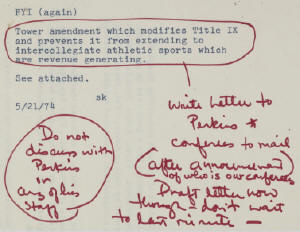
Patsy T. Mink, typed and handwritten notes on Tower Amendment to Title IX, May 21, 1974. Patsy T. Mink Papers, Container 184, Manuscript Division. Used with permission of Gwendolyn Mink.
|
Patsy T. Mink, press release, November 14, 1995, urging President William J. Clinton to veto welfare bill.
During her second tenure in Congress, Mink devoted considerable attention to welfare reform, becoming a key critic of both Republican and Clinton administration plans to overhaul the system. She advocated the preservation of a federal safety net for families and children in poverty and opposed the elimination of Aid to Families with Dependent Children. In 1995, Mink crafted a substitute welfare bill, one of only two Democratic alternative bills voted on by the House. In November 1995 when it became clear that the welfare bill emerging from the conference committee was backpedaling on provisions Democrats had gained in the House version, Mink organized support for a joint congressional letter urging a presidential veto. Clinton vetoed two welfare bills in December 1995 and January 1996, but in August 1996, he signed the Personal Responsibility and Work Opportunity Reconciliation Act, despite intense liberal opposition to it.
|

Patsy T. Mink, press release, November 14, 1995, urging President William J. Clinton to veto welfare bill. Patsy T. Mink Papers, Container 1379, Manuscript Division. Used with permission of Gwendolyn Mink.
|
Patsy T. Mink on the House floor protesting the Florida vote count in the 2000 presidential election, January 6, 2001.
On January 6, 2001, a joint session of Congress met to certify the electoral vote in the contested 2000 presidential election between George W. Bush and Al Gore, at which Vice President Gore presided in his capacity as president of the Senate. In a protest that was largely symbolic, members of the House of Representatives, mostly from the Congressional Black Caucus, rose individually to block the counting of Florida’s electoral votes, arguing that the state’s black voters had been disenfranchised. As shown here, Mink joined in this effort, but Gore, as he did in all cases, ruled her objection out of order because the law required that such objections have a sponsor from both houses. No senator would cosponsor the objections, deferring to the Supreme Court ruling in Bush v. Gore, which had settled the issue in Bush’s favor. |
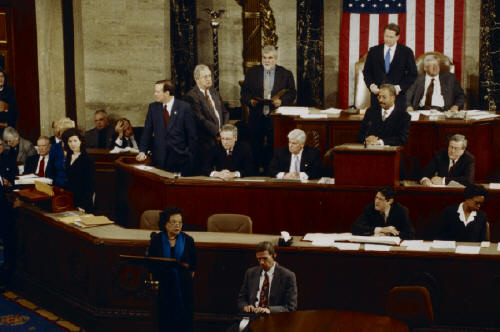
Patsy T. Mink on the House floor protesting the Florida vote count in the 2000 presidential election, January 6, 2001. Photographer unknown. Patsy T. Mink Papers, Manuscript Division.
|
|
 The
Library of Congress >> Researchers
The
Library of Congress >> Researchers












